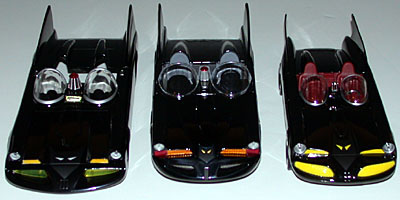
Three versions of the 1960s Batmobile have appeared recently as collectible 1/24 scale diecast vehicles. The first was made by Johnny Lightning, followed by a car from the Danbury Mint, then most recently one by the makers of the classic 1960s TV car, Corgi. So which one is best?
Packaging
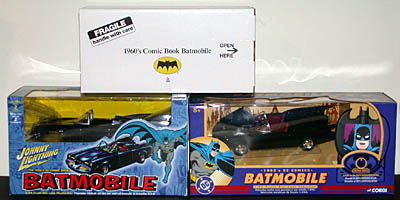
The Johnny Lightning and Corgi cars both come in a window box, while the Danbury Mint car comes in a nearly featureless white box. Although the box design of the Johnny Lightning car is slightly better, with windows at each end of the box to see the front and rear of the car, the Corgi model makes for a better "Mint in Sealed Box" piece since the car is fully assembled.
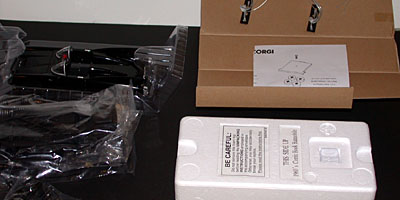
All three keep the car safe from damage in different ways. Johnny Lightning has the car body surrounded by plastic blisters (the engine, interior, and chassis have to be assembled, and are packaged separately in the lower half of the box). The Danbury Mint has the car sandwiched between two large styrofoam pads and covered in tissue paper with foam inserts. Corgi has the car held to a plastic base and sturdy cardboard floor with four twist-ties, one behind each wheel over the axle. The twist-ties make the Corgi car the only one of the three that can't be replaced easily once removed from the box. If you don't plan to take it out of the box, though, Corgi is definitely on top here.
Accessories
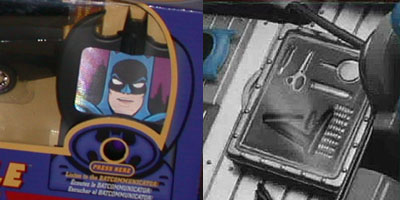
The Johnny Lightning car comes with no accessories beyond the kit itself, which comes disassembled. Corgi includes a "Bat Communicator" that speaks four phrases: "The Joker will not escape this time," "I don't need guns to protect this city," "Contact Alfred in the batcave," and "I swore to stand watch while Gotham City sleeps." The picture of Batman on the communicator moves with each phrase. The only loose accessory in the Danbury Mint car is the magnetic field kit that can be placed under the rear deck.
The Bat Communicator is an interesting device, but it seems to be geared toward a younger demographic than what would be interested in a replica of a car from the '60s. It would've been nice if the Danbury Mint car had the figures as separate accessories, but they were instead glued to the seats and could only be removed by damaging and subsequently repairing the seats (I removed the figures in my own car; details about the modification can be seen on my scale modeling site). Even so, the Danbury Mint wins out for accessories by being the only company to include an accessory that actually works directly with the Batmobile.
Models
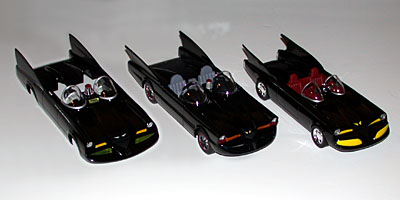
Once you're past the packaging and accessories, this is what it really comes down to, right? All three companies have the familiar twin-bubble, twin-headrest design of the comic book car, but all three interpreted the car differently. Johnny Lightning's replica is the largest, and nails the overall design almost perfectly with rear-tapered headlight covers, large triangular openings the front of the car, taillights in the fins, and rocket thrusters flanking a wide chrome bumper with two small nozzles. The only thing they got "wrong" is placing lights in the front openings - these were usually colored black in the comics, suggesting grill openings. The Danbury Mint Batmobile is slightly smaller, and mixes in some TV car elements like the forward-tapering headlight covers and split grill. Unlike the TV car, it also has thin fins, taillights in the rear nacelles, and a grill in the back center of the car. Corgi's Batmobile is the smallest, and seems to be a cross between the Danbury Mint and Johnny Lightning cars with rear-tapered headlight covers, yellow painted mesh areas, thin fins, taillights in the nacelles, and an oblong design on the rear panel similar to the Danbury Mint's rear grill.
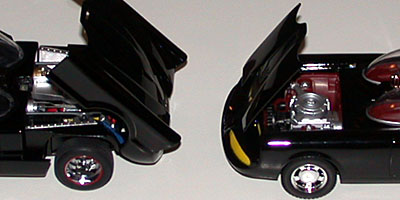
Under it's unique tilt-nose hood, the Danbury Mint car lives up to the Mint's reputation. The race-inspired engine is beautifully detailed down to the ignition wires, and includes hoses, belts, and a moving intake fan. Johnny Lightning's generic block, under a simpler rear-opening hood, is clearly based on a Ford engine. Although simplified, it can be detailed into a nice looking replica with some work. Corgi's Batmobile has a solid bumper-to-bumper belly pan, and so engine details are minimal. Like JL's car, it has a rear-opening hood over an almost-Ford engine, but the details have been severely simplified and there is no bottom half to the engine. For the chassis, the Danbury Mint car again has the most detail (including working suspension pieces), with Johnny Lightning having a good base for anyone who wants to add their own detail. Both the JL and DM Batmobiles have working front steering. Corgi's Batmobile has absolutely no chassis detail, opting instead to use the base of the car for a 3-D relief of Batman. The Danbury Mint has the only car to feature opening doors and rear hatch.
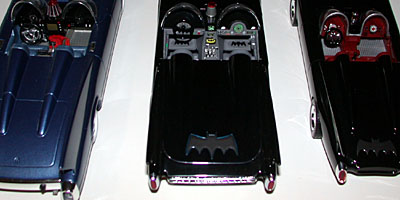
The interiors of cars all use the same basic design - twin curved dashboards with centered gauge clusters, a signal beacon between the windshields, and the telephone and gear selector(s) between the bucket seats. As with the engine, the Danbury Mint car has the most detail, including a swing-out lab set mounted on the passenger's side door. The only thing that seems to have been forgotten in this car was the telephone cord. Johnny Lightning's Batmobile has the same dash layout, but instead of the swing-out lab set it has a grappling hook gun molded into the base of the door. The Johnny Lightning Batmobile also has the best signal beacon, a nice tapered transparent red piece with cleanly painted silver ribs and a transparent red top (The DM car has tighter ribs that negate the red "beacon" part, and the Corgi car is chrome-plated with red paint for the light parts). Corgi's offering is, again, more simplified - the dash still has the gauge faces and buttons, but the space where the TV screen is on the other two cars is a plain, featureless panel.

Although all three manufacturers painted the cars black, the comics and recent DC Direct products generally portray the car in medium-dark blue (my finished Johnny Lightning Batmobile was used as a stand-in for the interior and chassis photos - the model is not blue out of the box). However, since black is both the traditional Batmobile color as well as the color of the Futura Batmobile the comic car was based on, I'll not fault any of the companies for this choice. The paint on the Danbury Mint Batmobile is as well done as the detail work: the black is smooth & deep, with no visible flaws. The bat-head emblem on the hood and flared bat emblem on the trunk both have a thin blue outline to set them out against the rest of the black. Johnny Lightning's paint job is as clean as the Mint car, and though it lacks a trunk emblem, it has a hood mask in flat black set against the gloss black body. The Corgi Batmobile uses a metal-flake black, which looks neither as deep nor as smooth as the paint on the other two cars. The paint looks especially thin inside the fins, which were bent on the car I got. I don't know if the paint or the bent fins are common problems or not, but both detract from the overall model quite a bit. The Corgi Batmobile has the same hood and trunk emblems as the Danbury Mint car, though the definition is not as well done and the emblems tend to get lost.
Final Thoughts
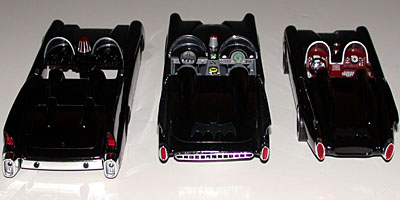
Corgi's Batmobile is a good effort, but I think they could have put forth a better product than they did. The car feels lighter than either of the other cars, as if it were made of a less substantial metal. This thought was solidified when I noticed the bent fins, which I could easily straighten barehanded. Things like the signal beacon, cast in translucent plastic and then chrome plated and painted red, aren't really bad, just...odd. Overall it's a fun little replica, but not as strong as the Danbury Mint or Johnny Lightning cars.
The Danbury Mint created a beautiful replica, but it's not without it's drawbacks. The overall shape of the car borrows from both the TV and the comic book designs, while looking exactly like neither. The car also lost some points by having the figures glued into place instead of being removable (nothing hinders putting them into or taking them out of the car, so I don't know why it was done this way). The biggest drawback, however, is the price. At USD$150 new, it is nearly ten times the price of either the Corgi or Johnny Lightning cars.
Johnny Lightning was the first to offer a 1/24 diecast 1960s Batmobile, and it's still the best. Details aren't as numerous as the Danbury Mint car, but the base for all these details is ready for any modeler who wants to add them. The shape of the car is more comic-accurate as well. The thing that definitely puts Johnny Lightning over the top is the price - at under USD$20 new, they're still very affordable on the secondary market. If you have any modeling experience at all, or even if you're willing to tackle it just this once, the Johnny Lightning car is still the best car available.
